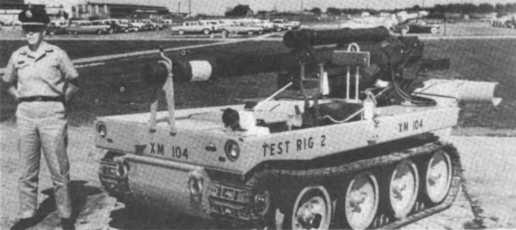XM104 on:
[Wikipedia]
[Google]
[Amazon]


 The XM104 was a U.S.-developed self-propelled amphibious/air-droppable/heliborne 105 mm howitzer. Pilot models of the howitzer were built by the U.S. Army Ordnance Tank Automotive Command's Experimental Division at the
The XM104 was a U.S.-developed self-propelled amphibious/air-droppable/heliborne 105 mm howitzer. Pilot models of the howitzer were built by the U.S. Army Ordnance Tank Automotive Command's Experimental Division at the
Boeing Technical Report D210-10506-1 October 1972
DAAFO3-72-C-OO116, The Boeing Company, Vertol Division
OTAC Developing Self-Propelled Howitzer, XM-104
// ''Army Research and Development'', June 1962, v. 3, no. 6, p. 15. Abandoned military projects of the United States 105 mm artillery Self-propelled howitzers of the United States Tracked self-propelled howitzers Self-propelled artillery of the United States Cold War artillery of the United States {{artillery-stub


 The XM104 was a U.S.-developed self-propelled amphibious/air-droppable/heliborne 105 mm howitzer. Pilot models of the howitzer were built by the U.S. Army Ordnance Tank Automotive Command's Experimental Division at the
The XM104 was a U.S.-developed self-propelled amphibious/air-droppable/heliborne 105 mm howitzer. Pilot models of the howitzer were built by the U.S. Army Ordnance Tank Automotive Command's Experimental Division at the Detroit Tank Arsenal
Detroit Arsenal (DTA), formerly Detroit Arsenal Tank Plant (DATP) was the first manufacturing plant ever built for the mass production of tanks in the United States. Established in 1940 under Chrysler, the plant was owned by the U.S. government ...
shops, Warren, Mich. A follow-up model is known as XM204.
Mobility
The vehicle represented a new concept ofself-propelled artillery
Self-propelled artillery (also called locomotive artillery) is artillery equipped with its own propulsion system to move toward its firing position. Within the terminology are the self-propelled gun, self-propelled howitzer, self-propelled mo ...
, it could be stripped for air delivery by helicopter
A helicopter is a type of rotorcraft in which lift and thrust are supplied by horizontally spinning rotors. This allows the helicopter to take off and land vertically, to hover, and to fly forward, backward and laterally. These attributes ...
, parachute drop or ground-landing by the Army's DHC-4 Caribou
The de Havilland Canada DHC-4 Caribou (designated by the United States military as the CV-2 and later C-7 Caribou) is a Canadian specialized cargo aircraft with short takeoff and landing ( STOL) capability. The Caribou was first flown in 1958 ...
and Air Force C-130 Hercules
The Lockheed C-130 Hercules is an American four-engine turboprop military transport aircraft designed and built by Lockheed Corporation, Lockheed (now Lockheed Martin). Capable of using unprepared runways for takeoffs and landings, the C-130 ...
. Brig. Gen. J. Frederick Thorlin, Commanding General of OTAC, said the full-tracked vehicle, designated the XM104, was developed in answer to the Army's urgent request for a "heavyweight puncher with featherweight mobility."
Characteristics
XM104 had a 4-man crew, was to travel at 35 miles per hour, negotiate swamps and desert sand, cross rivers and lakes. Combat weight of the vehicle was around 6,400 pounds.Capabilities
The XM104 was designed to provide ground troops with a "scatback" artillery piece which could travel anywhere in the world with airborne combat troops. Once on line, it could follow right behindinfantry
Infantry is a military specialization which engages in ground combat on foot. Infantry generally consists of light infantry, mountain infantry, motorized infantry & mechanized infantry, airborne infantry, air assault infantry, and marine i ...
or armour unit
Armoured warfare or armored warfare (mechanized forces, armoured forces or armored forces) (American English; see spelling differences), is the use of armored fighting vehicles in modern warfare. It is a major component of modern methods of ...
s.
XM204
A similar designation is known with the model ''XM204 Soft Recoil Howitzer'', which had swamp-rollers and could be towed by trucks. With this artillery piece the army examined also an airborne version withBoeing CH-47 Chinook
The Boeing CH-47 Chinook is a tandem rotor helicopter developed by American rotorcraft company Vertol and manufactured by Boeing Vertol. The Chinook is a heavy-lift helicopter that is among the heaviest lifting Western helicopters. Its name, Ch ...
helicopters. The aerial artillery design Study is known as: ''Two Externally Mounted XM204 Howitzers on a CH-47C Helicopter''DAAFO3-72-C-OO116, The Boeing Company, Vertol Division
References
OTAC Developing Self-Propelled Howitzer, XM-104
// ''Army Research and Development'', June 1962, v. 3, no. 6, p. 15. Abandoned military projects of the United States 105 mm artillery Self-propelled howitzers of the United States Tracked self-propelled howitzers Self-propelled artillery of the United States Cold War artillery of the United States {{artillery-stub